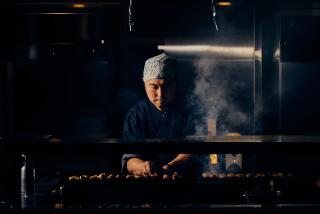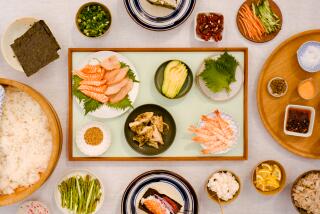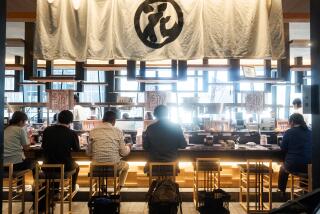Culture : Japanese Losing Their Grip on Ancient Skill of Wielding Chopsticks : Most young children don’t know the proper technique. Some even commit the ultimate crime: spearing their dinner.
- Share via
TOKYO — Do you fumble with chopsticks, dropping food midway between plate and mouth before surrendering to the good old fork?
If so, take heart. Research shows that even the Japanese are forgetting the ancient art of eating with two sticks.
“Japanese have been using chopsticks for more than 1,300 years, and it’s a representative cultural asset,” said Masaaki Yatagai, a children’s education specialist at Mejiro Gakuen Women’s College. “Yet, Japanese today can’t use chopsticks properly at all.”
He even has statistics to prove his point. According to a 1990 study by the Children’s Life Science Research Center in Tokyo, where Yatagai is a representative, only 10.6% of elementary school students could correctly use chopsticks, compared to 15.7% in 1984. The success rate varies from 1.8% among first-graders to 17.8% among sixth-graders. In 1936, he says, nearly 75% of 3-year-olds used chopsticks correctly.
To Yatagai, it all adds up to a national chopstick crisis that threatens not only Japan’s cultural foundation but also the fabled dexterity of its people. He won’t go quite so far as to say that chopstick use has helped the Japanese become masters of precision, contributing to their economic success, but plenty of other scholars do.
For instance, Kisou Kubota, director of Kyoto University’s Primate Research Institute, claims there is a link between chopsticks, manual dexterity and the ability to think. (No, Japanese monkeys don’t use chopsticks; Kubota’s special area of study is the relationship between physical movement and the brain.)
And to Tadashi Matsuura, creator of a device meant to help train young fingers to properly hold chopsticks, what’s at stake is a person’s value in society.
“If children poke their food with chopsticks, it says something about their home environment. And on that front, they will be evaluated as a member of society,” said Matsuura, manager of Tombow Pencil Co., Japan’s leading stationery maker.
Tapping a deep streak of cultural self-consciousness, Tombow has sold more than 93,000 chopstick-training sets in the 18 months since their debut--more than three times original projections. This year, the firm has added an $80 chopstick-training video to its product line, hoping to sell it to schools.
For the uninitiated, the major taboos of chopstick usage include crossing the implements or gripping them so tightly that they touch, leaving no space in between the sticks. Spearing food with a chopstick is the ultimate horror.
Bad form is not only an eyesore but it also limits the size and scope of objects that can be picked up. According to the Children’s Life Science Research Center, children with correct form are far more successful in picking up particularly thin or slippery food, such as sliced cucumbers and a small gooey mushroom known as nameko .
The ideal form, according to chopstick experts here, is to anchor one stick down with the base of the thumb and rest it on the fourth finger. This chopstick should never move. The second stick is held with the thumb, second and third fingers. This stick should move freely, pinching bites of food.
None of which much impresses the first-graders at Kinka Elementary School in central Tokyo. Told that visitors had come to see how well they used hashi , the Japanese word for chopsticks, one boy sang out, “Oh, what a hassle chopsticks are!”
As the children attacked their lunchtime meal of sausage, spaghetti, roll and soup, they rambunctiously called out to be interviewed and photographed, proudly showing their chopstick techniques. Alas, it was a sea of crossed sticks, or sticks gripped together, ends touching.
Some children gave up trying to pick up the spaghetti with chopsticks and fastened their mouths to the plates instead, shoveling the noodles in with their sticks. Others simply surrendered to the fork.
Many of the children said they learned how to use chopsticks from their mothers, older sisters or grandparents. Others said they learned themselves by watching others.
Had they ever been corrected? Yes, said Mariko Iizuka, 7. “My mommy told me crossing chopsticks like this,”--she held her chopsticks aloft at right angles-- “was no good.” Then, as she resumed eating, she inadvertently crossed them again.
Most children, however, said they had never been corrected.
The great divide between proper users and improper ones was World War II, Yatagai said. Faced with poverty and misery after the war, Japanese parents had neither the time nor the luxury to teach their children the niceties of chopstick use. As those children grew up, they were hardly qualified to serve as models for their offspring. As a result, the art diminishes with each generation.
In addition, more schools now serve cafeteria food eaten with spoons. Before, most mothers made Japanese-style lunches for their children, eaten with chopsticks.
“The kids are pretty terrible using chopsticks,” acknowledged Teiko Tsuchida, first-grade teacher at Kinka Elementary. “But their parents don’t use them well either, so there is no one to teach them.”
However, added Tsuchida, the common attitude among parents is: “Their chopstick use is not pretty to watch. But as long as they’re able to eat with them . . . isn’t that OK?”
More to Read
Sign up for Essential California
The most important California stories and recommendations in your inbox every morning.
You may occasionally receive promotional content from the Los Angeles Times.











